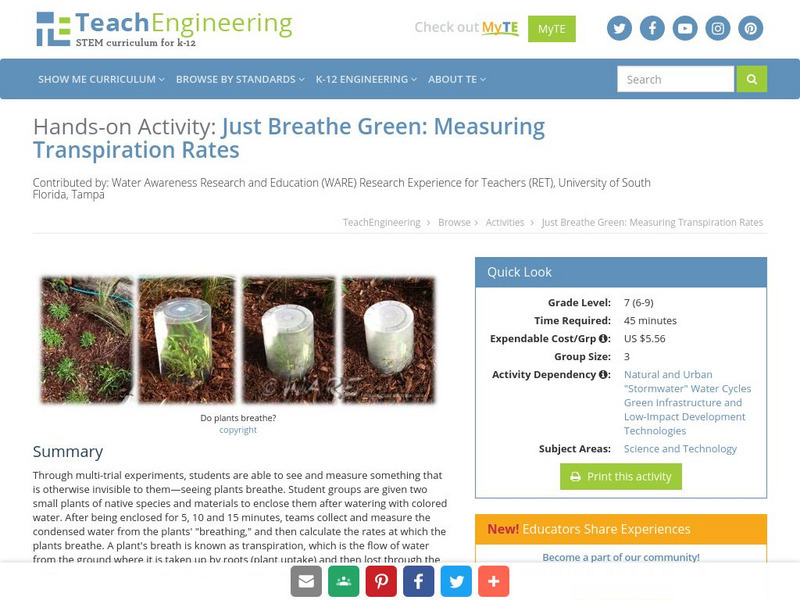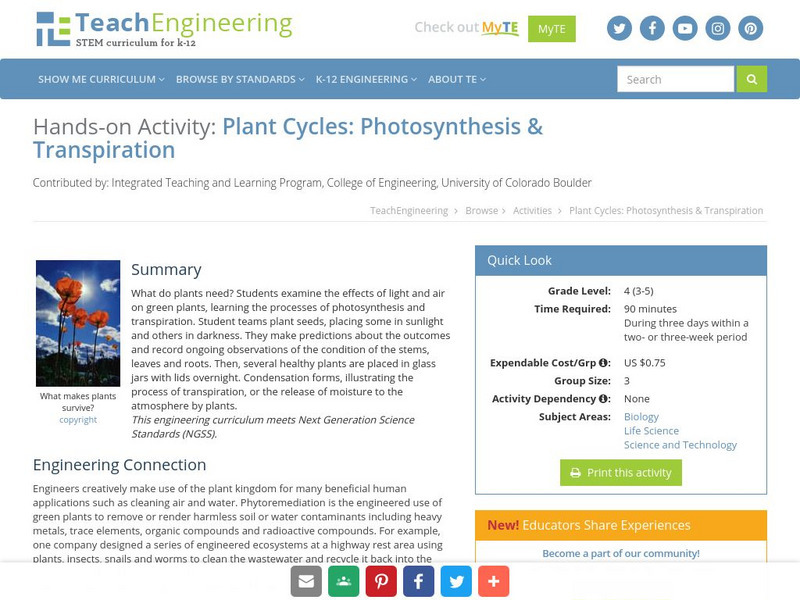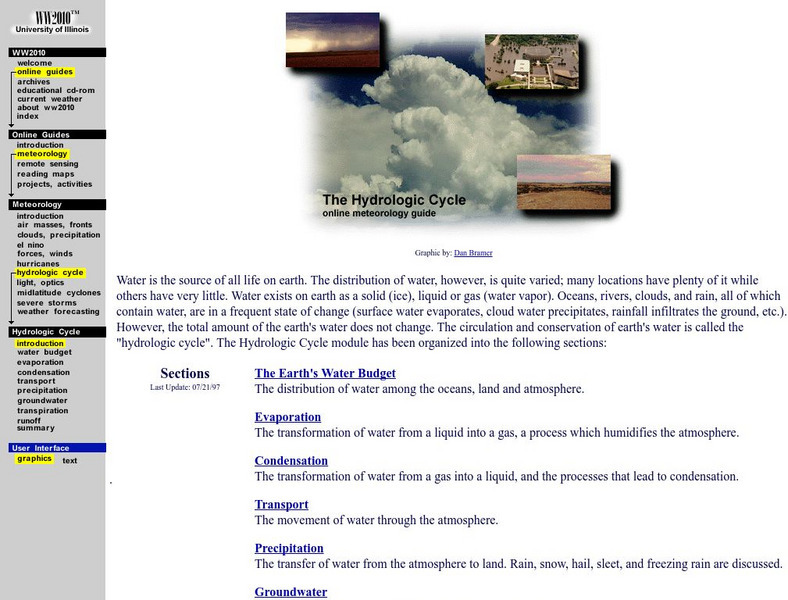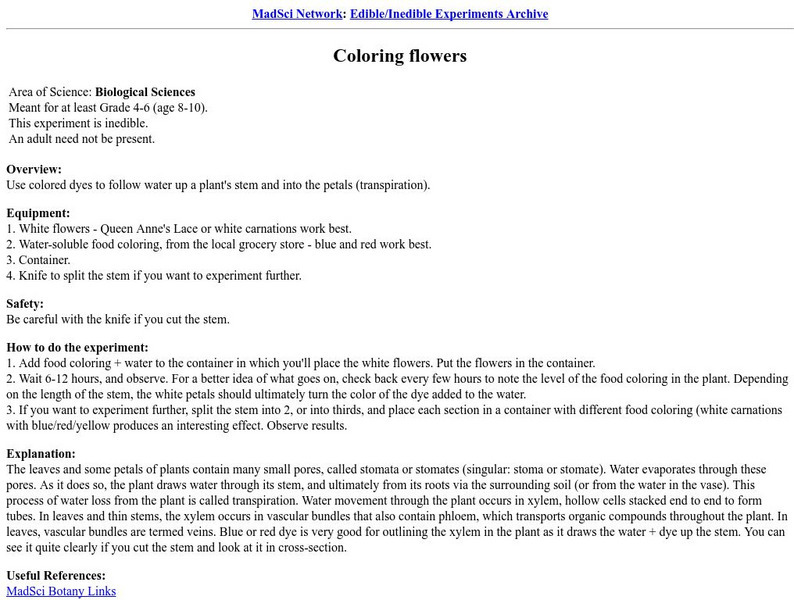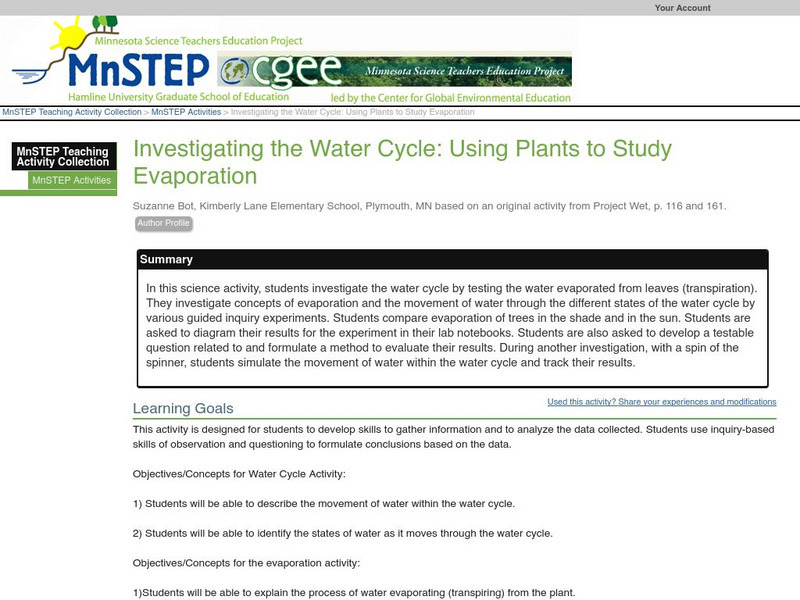University of Nebraska
University of Nebraska: Transpiration Water Movement Through Plants
This tutorial examines how water moves through a plant. Follow the pathway that water takes through plants from the roots to evaporation from cells in the leaves. Learn what controls rates of transpiration, how environmental conditions...
TeachEngineering
Teach Engineering: Just Breathe Green: Measuring Transpiration Rates
Through multi-trial experiments, students are able to see and measure something that is otherwise invisible to them- seeing plants transpire. This information will allow students to consider how a plant's unique characteristics (leaf...
TeachEngineering
Teach Engineering: Plant Cycles: Photosynthesis & Transpiration
What do plants need? Students examine the effects of light and air on green plants, learning the processes of photosynthesis and transpiration. Student teams plant seeds, placing some in sunlight and others in darkness. They make...
Ohio State University
Ohio State University: Plant Transpiration & Translocation
This is a good explanation of plant water balance issues and carbon fixing cycles. Transpiration processes are explained well with links to additional information.
University Corporation for Atmospheric Research
Ucar: Modeling Tree Transpiration
In this activity, learners will observe and measure the water given off through transpiration by a plant in a small terrarium.
National Health Museum
Access Excellence: Determining Transpiration From a Schoolyard Tree
A good project to link math skills with ecology. Hands-on activies help students understand the role of trees in ecosystems.
BiologyWise
Biology Wise: What Is Transpiration
Transpiration is an important plant process that releases water into the air through the stomata in leaves. This resource describes the process, the role the stomata play, factors that have an impact on transpiration, and why it is so...
University of Illinois
University of Illinois Urbana Champaign: The Hydrologic Cycle
Water is the source of life on earth. It exists in many forms and is constantly changing. The circulation and conservation of earth's water is called the hydrologic (or water) cycle. Find out how water evaporates, condensates,...
TeachEngineering
Teach Engineering: Corn for Fuel?!
In this activity, students examine how to grow plants the most efficiently. They imagine that they are designing a biofuels production facility and need to know how to efficiently grow plants to use in this facility. As a means of...
Can Teach
A Demonstration of Photosynthesis and Transpiration
Students of all ages wonder what happens to a seed when you plant it in the ground. Try this basic experiment and let them explore, pose questions, and make predictions.
TeachEngineering
Teach Engineering: Planting Thoughts
Students gain an understanding of the parts of a plant, plant types and how they produce their own food from sunlight through photosynthesis. They also learn about transpiration, the process by which plants release moisture to the...
Huntington Library
Huntington Library: What Plants Need in Order to Survive and Grow: Air [Pdf]
A lesson unit where learners work in small groups to examine stomata on a leaf's upper and lower surfaces. They then conduct an experiment to test whether plants can survive without air, learning about transpiration in the process.
MadSci Network
Coloring Flowers
Demonstrate plant transpiration for your students using a white flower and colored water. This is an easy experiment that shows how a plant takes in water and nutrients.
NOAA
Noaa: National Weather Service: Simplified Hydrologic Cycle
The National Weather Service offers information on the processes that make up the water (hydrologic) cycle, including evaporation and transpiration, precipitation, run-off, infiltration, and percolation. Has a good illustration and...
BiologyWise
Biology Wise: Stomata Function
Describes stomata and their functions in photosynthesis, transpiration, and regulation of water retention and loss by plants.
BBC
Bbc News: America's Day of Terror
This resource on the 9/11 attacks by the BBC includes information on the four hijacked planes, the World Trade Center, a diagram that lists all the companies that were located in the two towers of the World Trade Center, pictures from...
National Humanities Center
National Humanities Center: America in Class: America in the 1920s: "Machine Age"
The National Humanities Center presents collections of primary resources compatible with the Common Core State Standards - historical documents, literary texts, and works of art - thematically organized with notes and discussion...
Science Education Resource Center at Carleton College
Serc: Investigating the Water Cycle: Using Plants to Study Evaporation
In this science activity, students investigate the water cycle by testing the water evaporated from leaves (transpiration). They investigate concepts of evaporation and the movement of water through the different states of the water...
Yad Vashem, The World Holocaust Remembrance Center
Yad Vashem: The Individual and Togetherness in the "Witness Education"
"Witnesses and Education" is a project in which survivors of the Holocaust tell their story in the actual location where the events transpired. This lesson is broken down into themes: Jewish community before the Holocaust, Jewish...
National High Magnetic Field Laboratory
Magnet Academy: Svante Arrhenius
Svante Arrhenius was born in Vik, Sweden, and became the first native of that country to win the Nobel Prize. The award for chemistry was bestowed to him in honor of his theory of electrolytic dissociation. Arrhenius also developed the...
US Department of State
Office of the Historian: Tehran Conference, 1943
A thorough discussion of what transpired at the Tehran Conference in December, 1943, among the Allied leaders. Find out about future war strategy as well as postwar plans for Europe and the Pacific.
TeachEngineering
Teach Engineering: Witnessing Evaporation
The engineers at Splash Engineering (the students) have been commissioned by Thirsty County to conduct a study of evaporation and transpiration in their region. During one week, students observe and measure (by weight) the ongoing...
TeachEngineering
Teach Engineering: Biodomes
Students explore the biosphere's environments and ecosystems, learning along the way about the plants, animals, resources and natural cycles of our planet. Over the course of lessons 2-6, students use their growing understanding of...
TeachEngineering
Teach Engineering: Photosynthesis Life's Primary Energy Source
This lesson covers the process of photosynthesis and the related plant cell functions of transpiration and cellular respiration. Young scholars will learn how engineers can use the natural process of photosynthesis as an exemplary model...
Other popular searches
- Plant Transpiration
- Transpiration of Plants
- Cell Transpiration
- Transpiration Questions
- Transpiration in Plants
- Water Transpiration
- Transpiration Water Cycle
- Photosynthesis Transpiration
- Rate of Transpiration
- Celery Transpiration
- Plant Transpiration Pdf
- Plant Transpiration Pd

